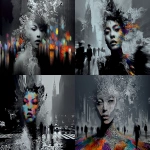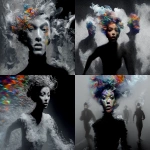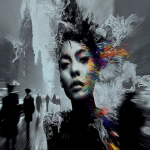Explore the Best AI Image Gallery

Beyond Pixels: How Wearable Tech is Expanding the Creative Canvas
The intersection of art and technology has always been a fertile ground for innovation. Now, with the advent of wearable technology, this convergence is reaching new heights, blurring the lines between the physical and digital realms and empowering creators to explore unprecedented artistic expressions.
From Concept to Creation: Wearable Tech as a Creative Tool
Wearable devices are no longer confined to fitness trackers and smartwatches. Artists and designers are leveraging these technologies to revolutionize their creative processes. Here are just a few examples:
- Interactive Installations: Imagine walking through an art exhibition where your movements trigger light patterns, soundscapes, or projections on the walls. Wearable sensors can capture your gestures and translate them into real-time interactive elements, immersing viewers in a dynamic and personalized experience.
- Gesture-Based Design: Artists are experimenting with wearables that respond to hand movements, allowing for intuitive sculpting, painting, or animation directly within virtual environments. This removes the constraints of traditional tools, opening up new possibilities for expressive freedom.
- Augmented Reality (AR) Experiences: AR overlays digital elements onto the physical world. Wearable headsets can enhance artistic creations by superimposing 3D models, interactive narratives, or soundscapes onto real-world settings, transforming everyday spaces into immersive art galleries.
The Ethical Dimensions of Wearable Art
As with any powerful technology, the integration of wearables into the creative sphere raises important ethical considerations:
- Data Privacy: Wearables collect vast amounts of personal data about users movements, preferences, and even biometric information. It is crucial to establish transparent data collection practices and ensure user consent for the use of their data in artistic creations.
- Accessibility and Inclusion: Not everyone has access to the latest wearable technology. Its essential to consider the potential for digital divides and strive for inclusive creative experiences that are accessible to a wide range of individuals.
- Authenticity and Ownership: The lines between human creativity and AI-generated content can become blurred when using wearables. It is important to establish clear guidelines regarding authorship and intellectual property rights in the context of collaborative creations involving both humans and machines.
Future Trends: Where Will Wearable Tech Take Us?
The future of wearable tech in the creative industry is brimming with possibilities:
- Brain-Computer Interfaces (BCIs): Imagine translating your thoughts directly into art, music, or interactive experiences using BCIs. This could revolutionize the way we create and consume artistic content.
- Immersive Storytelling: Wearables can transport us into fully immersive narratives, where viewers become active participants in the story unfolding around them. This has profound implications for film, theater, and gaming.
- Personalized Art Experiences: AI algorithms will likely play a greater role in tailoring artistic experiences to individual preferences, creating truly unique and personalized works of art.
Conclusion
Wearable technology is poised to redefine the creative landscape, empowering artists with unprecedented tools for expression and pushing the boundaries of what is possible. As we navigate this exciting new frontier, it is crucial to embrace ethical considerations, foster inclusivity, and ensure that technology serves as a catalyst for human creativity and innovation.


](https://images.ai-img.art/thumbnails/150/2ebdeb4f7db35100e5be5de9bc3e533a40d14e5feedefd7ffc586524a0f3ba8c.webp)
](https://images.ai-img.art/thumbnails/150/0ba0be922ab76af53f75ab90126ae2b18a600ee3b96941e8ab897a9f10594e5a.webp)
](https://images.ai-img.art/thumbnails/150/bd056a4718c27444e064198762f8dc8ffa1f74f1afd7dcda8d5cb8b142797d6e.webp)
](https://images.ai-img.art/thumbnails/150/ff09e32d2be011c0dd785984c5c1e47839ce551a31da1bde242860b30df2aa30.webp)












](https://images.ai-img.art/thumbnails/150/847809c77ca9a73b68bc190e6efb06fec87157685a243730d5a66a403b0e6e10.webp)












](https://images.ai-img.art/thumbnails/150/a3ed6513a6661aa3ee46e0c2924d1e8888854e91d8908de39db5590dc41f8d8f.webp)








](https://images.ai-img.art/thumbnails/150/7cf5a08238f29c821f52bb4f63db48af0b7f633ff3b9f7253074d78ced9ff6f6.webp)






](https://images.ai-img.art/thumbnails/150/685ae68cfab93a7e59a71206867b060c45bd6fd3cd561c4fe60fca514b09c5f8.webp)

